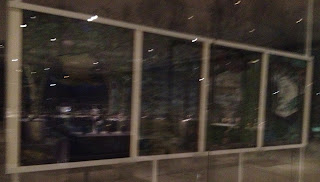If you've been keeping up with my blog you know that my family took a recent trip to the Toledo Museum of Art's Glass Pavilion. There we saw many amazing works of art glass ranging from hand blown chandeliers to ancient painted mirrors.
 |
| Two "venetian" vases handblown by Dale Chihuly. |
While I am always willing to gaze upon any type of glass art, my real enthusiasm is for works of stained glass. After searching the entire Glass Pavilion, we finally located the 5 stained glass panels in the museum.
 |
Louis Comfort Tiffany stained glass at night.
Unlit. In a glass museum. Where people come to view glass art. |
To my great dismay, we discovered that all the stained glass pieces were unlit. I am still asking myself why a glass museum would allow any of their treasures to be on display but un-viewable. It would be a lie to say I "took this in stride." In fact, there was a moment or two of what could be labeled an emotional breakdown. Luckily the room was so DARK that no one noticed. I don't think.
I tried to cheer myself with a Matisse...
 |
| Apollo |
A Miro`...
 |
| Woman Haunted by the Passage of the Bird-Dragonfly Omen of Bad News, 1938 |
And a Picasso.
 |
| Woman in a Black Hat, 1909 |
But is is only because I have the most wonderful, most understanding, most generous husband in the world, that I was able to rise from my depression. He agreed that we would be able to make a return trip to the Toledo Museum of Art Glass Pavilion the following morning to view the stained glass in their daytime glory. What a guy!
 |
Jardin Sous la Pluie (Garden in the Rain), by Francis Chigot
I love how the glass pieces in the center area of this panel seem to glow brighter than the surrounding pieces. The artist achieved this simply by choosing glass pieces with varying opacity and transparency. |
The above Art Deco style window was created in 1928 by french artist, Francis Chigot. Setting up his workshop in 1907, Chigot quickly became France's leading stained glass artist, rivaling America's Louis Comfort Tiffany. Chigot is most well know for his work with France's national monuments and restorations of stained glass windows destroyed during World War I.
 |
| Detail of Francis Chigot's Garden In the Rain, 1928 |
Garden in the Rain was inspired by Claude Debussy's 1903 piano piece Estampe No. III, "Jardins sous la pluie." The colors and shapes of the window capture the tone of Dubussy's composition suggesting driving rain and dripping vegetation, but with a hint of blue sky to come.
 |
| Four windows by Louis Comfort Tiffany discovered in Mausoleums of the historic Woodlawn Cemetery in Toledo, Ohio |
What a difference a little light makes, don't you think? The four Tiffany windows in the Glass Pavilion's collection were discovered in a local Toledo cemetery. What a find!
 |
Landscape Window with Mount Washington, New Hampshire, 1929
from the Snyder Mausoleum |
Today Louis Comfort Tiffany is widely recognized as one of America's leading glass designers around the 1900's, but during his lifetime he was best known primarily as a designer of religious art, particularly memorial windows. His windows were installed by the thousands, mostly in Protestant churches and cemetery mausoleums, and were the bulk of his business over four decades.
 |
Landscape Window with View of Lake and Distant Mountains, 1922
from the Fisk-Collins Mausoleum |
Tiffany's earliest windows generally depicted standard religious subjects and mimicked contemporary religious paintings. By the late 1890's Tiffany and his staff began producing a new type of religious window with nature as its subject.
 |
"River of Life" Memorial Window: Eventide, 1914
from the Layng Mausoleum |
Some windows showed religious symbols nearly obscured by flowers and plants, while others featured landscapes including no religious symbols. Using a range of new glass types and a variety of experimental methods, Tiffany produced vivid realistic trees and brooks, skies at dawn and dusk, and spring and autumn foliage.
 |
"River of Life" Memorial Window: Daybreak, 1914
from the Layng Mausoleum |
I can look at Tiffany widows for hours on end. It never ceases to amaze me how the artists at Tiffany studios can manipulate their glass selections in a way that may trick you into thinking you are viewing a painting rather than pieces of glass. But alas, my family was parked at the curb. As I returned to them, camera full of photos, mind filled with inspiration, it was with a much lighter heart than the last time I left the Glass Pavilion.





































